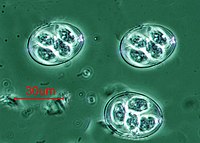
qPCR estimates of Babesia bovis and Babesia bigemina infection levels in beef cattle and Rhipicephalus microplus larvae
Sign Up to like & getrecommendations! Published in 2018 at "Experimental and Applied Acarology"
DOI: 10.1007/s10493-018-0260-0
Abstract: Babesia spp. are tick-transmitted intraerythrocytic apicomplexan parasites that infect wild and domestic animals. Babesia bovis and B. bigemina are endemic and responsible for enormous economic losses to the livestock industry in most of the Brazilian… read more here.
Keywords: babesia bovis; babesia; rhipicephalus microplus; bigemina ... See more keywords

Neither quantification by qPCR nor quantitative Elisa can be used to discriminate Angus cattle for resistance/susceptibility to Babesia bovis.
Sign Up to like & getrecommendations! Published in 2017 at "Ticks and tick-borne diseases"
DOI: 10.1016/j.ttbdis.2016.11.008
Abstract: With the aim of finding quantitative phenotypic traits that can be used to discriminate the levels of resistance/susceptibility to Babesia bovis, we estimated the repeatability and correlation between the level of infection, determined by the… read more here.
Keywords: babesia bovis; resistance susceptibility; bovis; susceptibility babesia ... See more keywords

Cross-priming amplification targeting the 18S rRNA gene for the rapid diagnosis of Babesia bovis infection.
Sign Up to like & getrecommendations! Published in 2021 at "Ticks and tick-borne diseases"
DOI: 10.1016/j.ttbdis.2021.101713
Abstract: Babesia bovis is a known causative agent of bovine babesiosis and is widely distributed across China. Rapid detection and accurate identification of B. bovis is essential for follow-up management and epidemiological investigations. In this study,… read more here.
Keywords: babesia bovis; 18s rrna; cpa assay; priming amplification ... See more keywords

A vibrational spectroscopic based approach for diagnosing Babesia bovis infection.
Sign Up to like & getrecommendations! Published in 2020 at "Analytical chemistry"
DOI: 10.1021/acs.analchem.0c00150
Abstract: Babesia bovis parasites present a serious and significant health concern for the beef and dairy industries in many parts of the world. Difficulties associated with the current diagnostic techniques include they are prone to human… read more here.
Keywords: babesia bovis; microscopy; vibrational spectroscopic; spectroscopic ... See more keywords

A Culture-Adapted Strain of Babesia bovis Has Reduced Subpopulation Complexity and Is Unable to Complete Its Natural Life Cycle in Ticks
Sign Up to like & getrecommendations! Published in 2022 at "Frontiers in Cellular and Infection Microbiology"
DOI: 10.3389/fcimb.2022.827347
Abstract: Babesia bovis natural field strains are composed of several geno-phenotypically distinct subpopulations. This feature, together with possible epigenetic modifications, may facilitate adaptation to variable environmental conditions. In this study we compare geno-phenotypical features among long-term… read more here.
Keywords: culture adapted; babesia bovis; adapted strain; strain ... See more keywords

Developing Anti-Babesia bovis Blood Stage Vaccines: A New Perspective Regarding Synthetic Vaccines
Sign Up to like & getrecommendations! Published in 2023 at "International Journal of Molecular Sciences"
DOI: 10.3390/ijms24065219
Abstract: Bovine babesiosis is caused by the Apicomplexa parasites from the genus Babesia. It is one of the most important tick-borne veterinary diseases worldwide; Babesia bovis being the species associated with the most severe clinical signs… read more here.
Keywords: bovis; bovis blood; developing anti; anti babesia ... See more keywords

Call for Caution to Consider Babesia bovis and Babesia bigemina as Anthropozoonotic Agents in Colombia. Comment on Kumar et al. The Global Emergence of Human Babesiosis. Pathogens 2021, 10, 1447
Sign Up to like & getrecommendations! Published in 2022 at "Pathogens"
DOI: 10.3390/pathogens11020263
Abstract: Currently, six species and two genetic variants within Babesia genus have been confirmed as human pathogens. Babesia bovis and Babesia bigemina are causative agents of bovine babesiosis, and, in spite of the worldwide distribution of… read more here.
Keywords: babesia; babesia bigemina; bovis babesia; bigemina anthropozoonotic ... See more keywords

Unraveling the Complexity of the Rhomboid Serine Protease 4 Family of Babesia bovis Using Bioinformatics and Experimental Studies
Sign Up to like & getrecommendations! Published in 2022 at "Pathogens"
DOI: 10.3390/pathogens11030344
Abstract: Babesia bovis, a tick-transmitted apicomplexan protozoon, infects cattle in tropical and subtropical regions around the world. In the apicomplexans Toxoplasma gondii and Plasmodium falciparum, rhomboid serine protease 4 (ROM4) fulfills an essential role in host… read more here.
Keywords: rhomboid serine; rom4; serine protease; bovis ... See more keywords

Comparative Degradome Analysis of the Bovine Piroplasmid Pathogens Babesia bovis and Theileria annulata
Sign Up to like & getrecommendations! Published in 2023 at "Pathogens"
DOI: 10.3390/pathogens12020237
Abstract: Babesia bovis and Theileria annulata are tick-borne hemoprotozoans that impact bovine health and are responsible for considerable fatalities in tropical and subtropical regions around the world. Both pathogens infect the same vertebrate host, are closely… read more here.
Keywords: bovis; nonproteinase homologs; bovis theileria; babesia bovis ... See more keywords